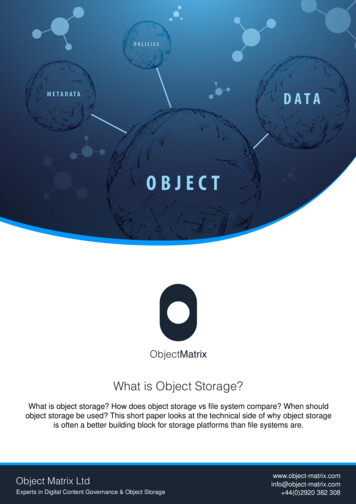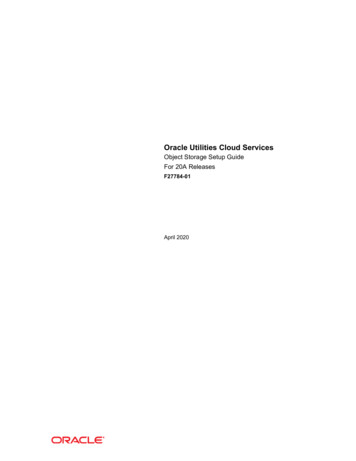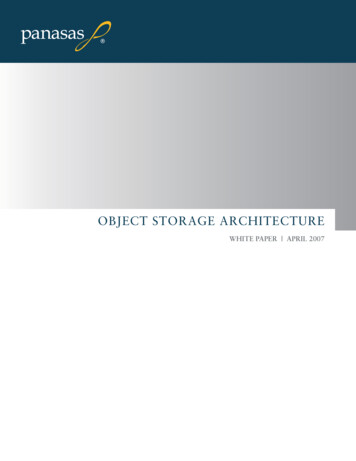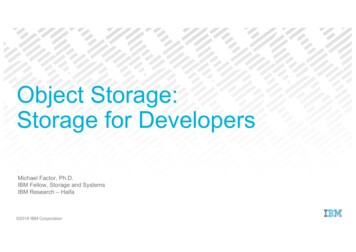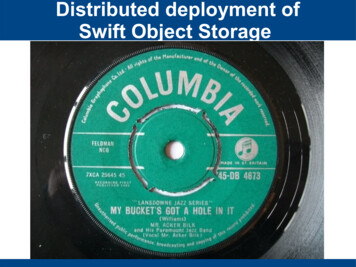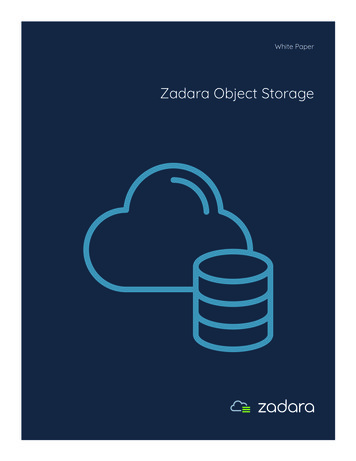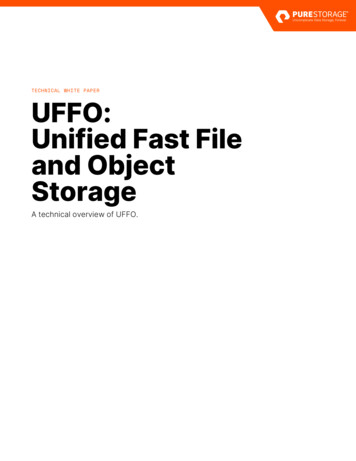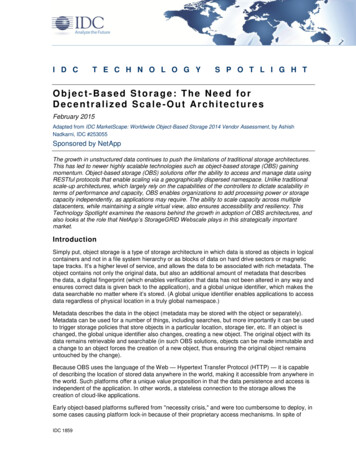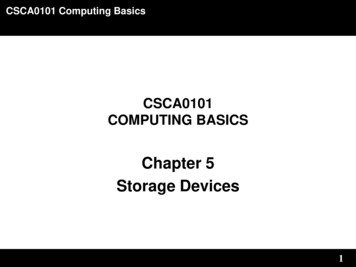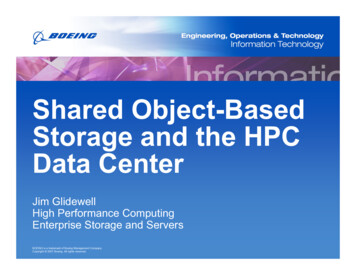
Transcription
Shared Object-BasedStorage and the HPCData CenterJim GlidewellHigh Performance ComputingEnterprise Storage and ServersBOEING is a trademark of Boeing Management Company.Copyright 2007 Boeing. All rights reserved.
Computing EnvironmentEngineering, Operations & Technology Information Technology Cray X1 2 Chassis, 128 MSPs, 1TB memory 46 TB storage managed by ADICStorNext HSM (5.5 TB online) 8 TB of direct-attached short-termstorage Linux Clusters Systems:––––2 128 node dual-Xeon (32 bit) clusters2 128 node dual-Opteron clusters3 256 node dual-Opteron clustersMore on the way All Clusters share access to a secondADIC StorNext HSMCopyright 2007 Boeing. All rights reserved.Enterprise Storage and Servers
History and Current IssuesEngineering, Operations & Technology Information TechnologyEnterprise Storage and Servers Used DMF (Data Migration Facility) since the early-90’sto manage disk space With the Cray X1, DMF was not an option An HSM was deemed essential Selected ADIC StorNext based on Cray support andrecommendation Initially for the Cray X1 only Soon after, chosen for Linux cluster as well The I/O demands of the cluster were severelyunderestimated, as was the cluster growth rate As our clusters have grown, StorNext has developedsignificant performance problemsCopyright 2007 Boeing. All rights reserved.
Hierarchical Storage Management - Pros & ConsEngineering, Operations & Technology Information TechnologyEnterprise Storage and Servers Pros Reduces storage costs Makes highly efficient use of disk space Allows users to view the storage available as “unlimited”– Eliminates need for user quotas– Reduces day to day storage maintenance issues Simplifies detailed storage capacity decisions Reduces backup requirements Cons Administration is complex and time-consumingUser delays waiting for file retrievalData tends to build without boundsSerious cleanup only occurs when a system is retiredMoving data from one HSM to a new one is very timeconsumingCopyright 2007 Boeing. All rights reserved.
Strategy for Shared StorageEngineering, Operations & Technology Information TechnologyEnterprise Storage and Servers Situation HPC storage was tied to computing platformNo common storage for all HPC systemsDuplication of data as user processes use multiple platformsCurrent Cluster SAN unable to deal with increasing load Needed a storage system To serve as a shared repository for HPC data– Preferred direct access from cluster, NFS option– High-performance NFS from Cray X1 To serve as a high-performance replacement for cluster SAN Wanted a solution to serve both functions Shared HPC permanent directoryCluster home directoryShared HPC temporary storage (7 - 30 days)Cluster temporary storage (7 - 30 daysCopyright 2007 Boeing. All rights reserved.
Storage System Selection CriteriaEngineering, Operations & Technology Information TechnologyEnterprise Storage and Servers Accessibility from all HPC systems NFS from the Cray X1 Direct client access from Linux clusters preferred Availability 24 by 7 uptime Concurrent storage system maintenance Reliability, resiliency, and redundancy Performance Ability to operate with a large number of clientsHigh single-node performanceHigh aggregate bandwidthScalable performance Manageability Ability to grow volumes seamlessly– No dump & reload– No performance penalty Simple interface for managementCopyright 2007 Boeing. All rights reserved.
Utilizing Panasas in Boeing HPCEngineering, Operations & Technology Information TechnologyEnterprise Storage and Servers Used for multiple functions Linux user home directoriesShared HPC user storageLinux high-speed temporary storageShared temporary storage Panasas directory for each user Linux home directory is a subdirectory Cray home directory remains on X1 Shared home directory between systems not desirable Different binaries, shell init scripts, etc. Common absolute path for permanent and temporarystorage on all HPC systems DirectFlow access from Linux clusters, NFS from CrayX1Copyright 2007 Boeing. All rights reserved.
Panasas Access MethodsEngineering, Operations & Technology Information TechnologyEnterprise Storage and ServersFSNDCopyright 2007 Boeing. All rights reserved.ltFci reow
User Directory StructureEngineering, Operations & Technology Information TechnologyEnterprise Storage and ServersLinux ClustersCray X1/share/joe/share/joe/acct/joe/acct/joe(home directory)(home directory) /joelinuxcray.Copyright 2007 Boeing. All rights reserved.originPanasas
Temporary Directory StructureEngineering, Operations & Technology Information TechnologyEnterprise Storage and ServersLinux ClustersCray X1/stmp/stmp/ptmp/ptmp/stmp/linux.Copyright 2007 Boeing. All rights reserved.Panasas
What is “Shared Object-Based Storage” ?Engineering, Operations & Technology Information TechnologyEnterprise Storage and Servers ANSI Standard OSD-1 r10 defines the Object-basedStorage Device (OSD) interface Multiple Vendors and Options LustrePanasasEMCHP Files exist as one or more objects, rather than groupsof blocks Storage is intelligent and can move these objectsaround for redundancy and/or performance Design goals are robustness, scalability, flexibility Storage interface is standardized, but metadatahandling is proprietaryCopyright 2007 Boeing. All rights reserved.
The Panasas Storage SystemEngineering, Operations & Technology Information TechnologyEnterprise Storage and Servers Realms, Bladesets, Volumes Logically, Panasas presents itself as:– a single realm, containing– one or more bladesets, each containing– one or more volumes Shelves, Blades Panasas hardware is delivered in– shelves (rack-mounted), which each contain– 11 blades Blades come in two types:– Director blades - manage metadata traffic, NFS access– Storage blades - contain drives & intelligent controller Access DirectFlow client on Linux NFS and SMB from other clientsCopyright 2007 Boeing. All rights reserved.
Panasas HardwareEngineering, Operations & Technology Information TechnologyCopyright 2007 Boeing. All rights reserved.Enterprise Storage and Servers
Panasas Hardware (continued )Engineering, Operations & Technology Information TechnologyCopyright 2007 Boeing. All rights reserved.Enterprise Storage and Servers
Our Panasas InstallationEngineering, Operations & Technology Information TechnologyEnterprise Storage and Servers Production - 52 Shelves of Panasas 3000 Storage Each shelf contains 2 director blades and 9 storage blades(2 9) 500 gigabytes per storage blade 4.5 terabytes per shelf raw capacity Seven racks, total of 234 terabytes raw capacity Evaluation System 3 1 10 shelves, 800 GB blades Used for initial evaluation– Administrator training and familiarization– Validated bladeset expansion process– Very rigorous testing Retained to test Panasas 3.x softwareCopyright 2007 Boeing. All rights reserved.
HPC Panasas StorageEngineering, Operations & Technology Information TechnologyCopyright 2007 Boeing. All rights reserved.Enterprise Storage and Servers
Panasas PerformanceEngineering, Operations & Technology Information TechnologyEnterprise Storage and Servers Performance is a function of multiple factors Network speedConcurrent usageNumber of shelves in bladesetAccess method– DirectFlow for Linux clients– NFS/CIFS for other clients NFS speed from Cray X1 35 Mbytes/second Single Stream from dual-Opteron node (gigabit link) Up to 85 MBytes/second Single shelf bandwidth 300MBytes/second 20 clients, 4 shelves 1.2 GBytes/second (60 MBytes/sec. average per client) Total aggregate bandwidth Over 10GBytes/second - limited by network bandwidthCopyright 2007 Boeing. All rights reserved.
Panasas IssuesEngineering, Operations & Technology Information TechnologyEnterprise Storage and Servers Bugs reported and resolved Evaluation system was extensively tested A large number of support cases were opened– Gathering needed debug data was time-consuming– The vast majority of these cases were closed quickly System limitations Needed to split realm - too many director blades Unable to mix blade disk sizes within a bladeset Scaling issues regarding administration– Time to reboot realm with new software Outstanding enhancement requests Management of multiple realms by a single GUISite-defined metadataTool to get stat() data in bulk (similar to SGI FS BULKSTAT)ACLsCopyright 2007 Boeing. All rights reserved.
Backup IssuesEngineering, Operations & Technology Information TechnologyEnterprise Storage and Servers Storage growth is having a big effect on backup Disk and RAID systems capacity growth exceeds thatof tape Traditional “Base incrementals” backup strategy isbecoming impractical Evaluated using the enterprise backup service Adding our storage would double weekly backupRequired significant upgrade to their hardwareWeekly base dumps were not practical“Synthetic base dumps” were an untried optionAnalysis showed that after 12 months, 75% of all data beingwritten to tape was data that had already been backed up HSM as a backup server Copyright 2007 Boeing. All rights reserved.
HSM as a Backup ServerEngineering, Operations & Technology Information TechnologyEnterprise Storage and Servers Basic Backup Strategy User storage is not managed by HSM HSM contains volumes and directories that match that of userstorage One-way file synchronization is done nightly––––From user storage to HSMCan be done on a volume or directory basisDisk to disk copyUses “rsync” command HSM migrates data to tape over time HSM-aware backup facility– xfsdump -a – Backs up inode information only– Data is on HSM-managed tapes HSM is not directly user accessibleCopyright 2007 Boeing. All rights reserved.
The Boeing HPC HSM Backup System - SpecsEngineering, Operations & Technology Information TechnologyEnterprise Storage and Servers Hardware SGI Altix 450– 16 cores– 48 gigabytes memory– 24 fibre channel ports 40 Terabytes of DDN-based storage (InfiniteStorage 6700) SUN/STK SL8500 Automated Tape Library– 1500 tape slots– 6 T10000 Drives Software SLES 9 SGI ProPack 4 DMF 3.6 TMFCopyright 2007 Boeing. All rights reserved.
The Boeing HPC HSM Backup System - HardwareEngineering, Operations & Technology Information TechnologySGI Altix 450Copyright 2007 Boeing. All rights reserved.STK SL8500Enterprise Storage and Servers
The Boeing HPC HSM Backup SystemEngineering, Operations & Technology Information TechnologyEnterprise Storage and sStorageCopyright 2007 Boeing. All rights reserved.BackupServerTape Library
HSM as a Backup Server - BenefitsEngineering, Operations & Technology Information TechnologyEnterprise Storage and Servers HSMs have proven functionality Mature and robust products HPC group has years of experience with DMF Data is written once to tapeOptimized usage of tape media, drivesHSM manages tape merges and “soft-deleted” dataFast recovery option in case of catastrophic failure ofprimary storage Suspend all work Mount HSM system in place of production storage Resume production Option to use (part of) the backup server as a true HSMCopyright 2007 Boeing. All rights reserved.
SummaryEngineering, Operations & Technology Information TechnologyEnterprise Storage and Servers Panasas has met our needs for a central HPC storagefacility Performance via DirectFlow client is very good, NFSaccess from the Cray is more than adequate Panasas has provided very good support, and wasvery responsive to bug reports Evaluation system was very helpful tool forfamiliarization and testing The use of an HSM as a backup server has been agreat success for us Users have been very happy with performanceCopyright 2007 Boeing. All rights reserved.
ANSI Standard OSD-1 r10 defines the Object-based Storage Device (OSD) interface Multiple Vendors and Options Lustre Panasas EMC HP Files exist as one or more objects, rather than groups of blocks . 40 Terabytes of DDN-based storage (InfiniteStorage 6700) SUN/STK SL8500 Automated Tape Library Ð1500 tape slots
